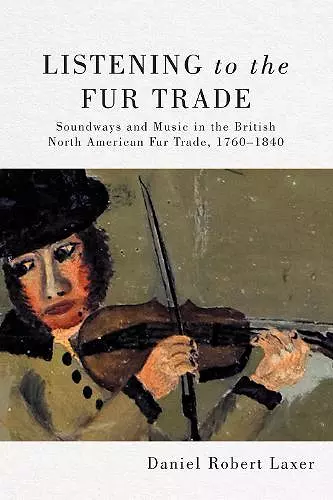Listening to the Fur Trade
Soundways and Music in the British North American Fur Trade, 1760–1840
Format:Hardback
Publisher:McGill-Queen's University Press
Published:5th Apr '22
Currently unavailable, our supplier has not provided us a restock date

A resounding history of cooperation, conflict, and commerce in the fur trade.
Listening to the Fur Trade uses the written record, oral history, and material culture to reveal histories of sound and music in an era before sound recording. Daniel Laxer uncovers songs and ceremonies of First Nations people, the paddling songs of the voyageurs, and the fiddle music and step-dancing at the trading posts that provided its pulse.
As fur traders were driven across northern North America by economic motivations, the landscape over which they plied their trade was punctuated by sound: shouting, singing, dancing, gunpowder, rattles, jingles, drums, fiddles, and – very occasionally – bagpipes. Fur trade interactions were, in a word, noisy. Daniel Laxer unearths traces of music, performance, and other intangible cultural phenomena long since silenced, allowing us to hear the fur trade for the first time.
Listening to the Fur Trade uses the written record, oral history, and material culture to reveal histories of sound and music in an era before sound recording. The trading post was a noisy nexus, populated by a polyglot crowd of highly mobile people from different national, linguistic, religious, cultural, and class backgrounds. They found ways to interact every time they met, and facilitating material interests and survival went beyond the simple exchange of goods. Trust and good relations often entailed gift-giving: reciprocity was performed with dances, songs, and firearm salutes. Indigenous protocols of ceremony and treaty-making were widely adopted by fur traders, who supplied materials and technologies that sometimes changed how these ceremonies sounded. Within trading companies, masters and servants were on opposite ends of the social ladder but shared songs in the canoes and lively dances during the long winters at the trading posts.
While the fur trade was propelled by economic and political interests, Listening to the Fur Trade uncovers the songs and ceremonies of First Nations people, the paddling songs of the voyageurs, and the fiddle music and step-dancing at the trading posts that provided its pulse.
“There has been much literature devoted to fur-trade canoe routes and voyageur life, but analyzing them through their soundscapes is very original. Daniel Laxer advances the intriguing idea that music and performance can be assessed as another form of exchange and thereby paints a different and more comprehensive picture of fur-trade labour and social relations. Listening to the Fur Trade will really shake up what we know about the fur trade.” George Colpitts, University of Calgary and author of North America’s Indian Trade in European Commerce and Imagination, 1580–1850
“Laxer's attention to the importance of music and sound as tools of diplomacy in relationship negotiations and as central to life in precolonial Canada is a rich and innovative settler approach to historical studies.” Pacific Northwest Quarterly
ISBN: 9780228008590
Dimensions: unknown
Weight: unknown
320 pages